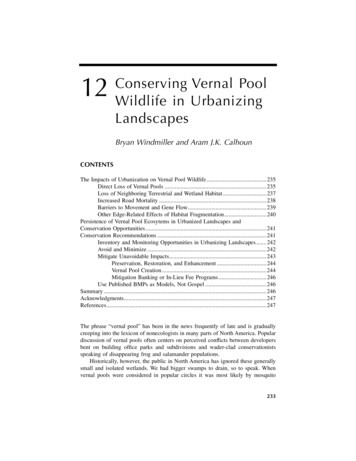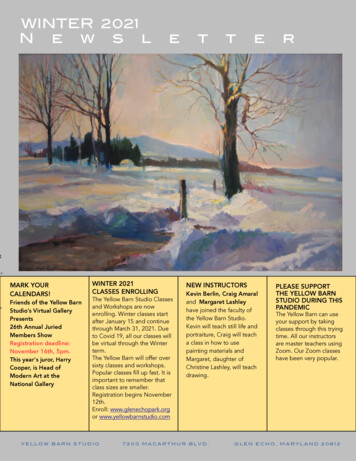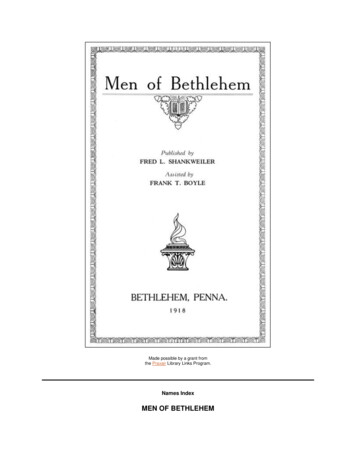
Transcription
3675 C012.fm Page 233 Thursday, June 21, 2007 8:43 AM12Conserving Vernal PoolWildlife in UrbanizingLandscapesBryan Windmiller and Aram J.K. CalhounCONTENTSThe Impacts of Urbanization on Vernal Pool Wildlife .235Direct Loss of Vernal Pools .235Loss of Neighboring Terrestrial and Wetland Habitat .237Increased Road Mortality .238Barriers to Movement and Gene Flow.239Other Edge-Related Effects of Habitat Fragmentation.240Persistence of Vernal Pool Ecosytems in Urbanized Landscapes andConservation Opportunities .241Conservation Recommendations .241Inventory and Monitoring Opportunities in Urbanizing Landscapes .242Avoid and Minimize .242Mitigate Unavoidable Impacts.243Preservation, Restoration, and Enhancement .244Vernal Pool Creation.244Mitigation Banking or In-Lieu Fee Programs.246Use Published BMPs as Models, Not Gospel .246Summary .246Acknowledgments.247References.247The phrase “vernal pool” has been in the news frequently of late and is graduallycreeping into the lexicon of nonecologists in many parts of North America. Populardiscussion of vernal pools often centers on perceived conflicts between developersbent on building office parks and subdivisions and wader-clad conservationistsspeaking of disappearing frog and salamander populations.Historically, however, the public in North America has ignored these generallysmall and isolated wetlands. We had bigger swamps to drain, so to speak. Whenvernal pools were considered in popular circles it was most likely by mosquito233
3675 C012.fm Page 234 Thursday, June 21, 2007 8:43 AM234Science and Conservation of Vernal Pools in Northeastern North Americacontrol officers talking about the need to drain or poison these pestilential mosquitoproducers. Today, however, there are vernal pool conservation and education organizations in New England, Toronto, New York, and many other places in our subjectregion. Near some vernal pools, human spectators are almost as abundant as themigrating spotted salamanders (Ambystoma maculatum) and wood frogs (Ranasylvatica) they have come to watch. Frogs and salamanders, once shunned as vermin(see references to the Second Plague, Exodus 8:1–11), are now all the rage in cuddlytoys and tee shirts.Perhaps many of us have developed a soft spot for vernal pools because theyare so accessible to us. Throughout our region, an increasingly high percentage ofpeople live only a short walk from a vernal pool, and this increase isn’t due to thefrogs and turtles moving into our backyards; rather, we are moving into theirs. Inrecent decades, humans in the northeastern U.S. and eastern Canada have abandoneddense frogless inner city neighborhoods to flock to new homes in sprawling suburbsor to exurban developments (residential development beyond the suburbs) in areasformerly dominated by agriculture and forestry. At the turn of the millennium, 79%of people in both Canada and the U.S. lived in areas defined by their respectivegovernments as “urban” (as opposed to “rural”; sources: www.canadainfolink.ca/and U.S. Census Bureau). In the same period, exurban, suburban, and urban landuses collectively consumed nearly half (49%) of the U.S. Eastern Temperate Forestecoregion, a fivefold increase from 1950 (Brown et al. 2005). As our human population sprawls across the landscape, the rate of increase in newly urbanized acreagefar exceeds the rate of human population growth (Theobald 2005; Johnson andKlemens 2005). Even where human population growth is stable or low, the redistribution of human populations is profoundly changing the natural landscape. Migration of people from urban areas to low density, large-lot residential development isincreasing. The relatively new development practice of first clearcutting and gradinglarger lots and then replacing native plant communities with manicured lawns andgardens transforms amphibian habitat from forest to “nonhabitat” and fragmentspotential forested corridors that help to link wetlands.Today, in much of our ecoregion, a turtle or salamander migrating to a vernalpool is far more likely to encounter lawns, roads, and buildings than cropland orclearcuts (Brown et al. 2005; Chapter 13, deMaynadier and Houlahan, for forestryimpacts). Although agricultural impacts to vernal pools are not discussed in thisvolume, the effects of habitat loss on amphibian movement and summer and winterrefugia are likely to be similar to effects from development. Urban landscapeelements pose novel and severe dangers to vernal pool wildlife populations. Yet,until recently, relatively few researchers addressed the problems of vernal poolconservation in urbanized landscapes. In this chapter, we review the growing bodyof literature concerning the impacts of urbanization-related processes: forest lossand fragmentation, road kill and barriers to movement, and other edge effects,upon vernal pool wildlife, particularly amphibians and turtles. We also providesome general recommendations for vernal pool habitat conservation in urbanizingareas.
3675 C012.fm Page 235 Thursday, June 21, 2007 8:43 AMConserving Vernal Pool Wildlife in Urbanizing Landscapes235THE IMPACTS OF URBANIZATION ONVERNAL POOL WILDLIFEResearch in the past decade has provided much insight into the impacts of urbanization on vernal pool wildlife and has clearly demonstrated the need for landscapelevel conservation efforts that extend far beyond the border of a single vernal pool(Burke and Gibbons 1995; Windmiller 1996; Semlitsch 2002; Burne and Griffin2005; Calhoun et al. 2005). The scope of this research is, however, uneven in itscoverage. Although much has been learned about the relationship between woodfrog (Rana sylvatica) and mole salamander (Ambystoma spp.) distribution and urbanland cover, very little is known about the distribution of vernal pool invertebratesin human-dominated landscapes (Chapter 6, Colburn et al.). In eastern North America, most research on the effects of urbanization on vernal pool fauna has beenconducted in the densely settled Boston–Washington corridor; fewer publicationsare available on urban impacts to vernal pools in eastern Canada, northern NewEngland, and the Midwestern U.S. To date, correlational studies comparing vernalpool amphibian distribution to land cover are much more common than empiricalstudies examining the fate of particular amphibian populations following the construction of houses or other urban land cover within or near vernal pools. Finally,most research on vernal pools in urban environments has focused on documentingthe impacts of urbanization on vernal pool wildlife; little is to be found in theliterature on factors that favor the persistence of these same species in our increasingly urbanizing region. The sections that follow summarize these compelling,though incomplete, research findings on the various impacts of urbanization uponthose vertebrate species most closely associated with vernal pools in our area:amphibians and turtles.DIRECT LOSSOFVERNAL POOLSVernal pools have been lost to urbanization through complete or partial filling (Figure12.1), draining, redirection of hydrological inputs, and the conversion of seasonallyflooded pools into permanent ponds with fish (Colburn 2004). They have beendestroyed for the purpose of converting land to human land-uses with higher economic value or in attempts to control mosquito populations (Chapter 6, Colburn etal.). Vernal pools are often small, seasonally flooded, and may be isolated fromlarger wetland systems (Chapter 2, Rheinhardt and Hollands). These characteristicsmake them particularly vulnerable to filling or direct alteration and also render vernalpools difficult to adequately protect through wetland regulations in the U.S. andCanada (Chapter 10, Mahaney and Klemens). In the Central Valley of California,King (1998) estimated that between 50 and 85% of presettlement vernal pool habitathad been destroyed, primarily through agricultural conversion. A recent study ofhistorical wetland loss in the Nanticoke River watershed in Delaware and Maryland(Tiner 2005), found that the heaviest losses occurred among forested freshwaterwetlands in either headwater or isolated landscape positions, precisely the type ofwetland most likely to harbor vernal pool habitat in our region. Urbanization in theNortheast has resulted in the complete disappearance of vernal pools from many
3675 C012.fm Page 236 Thursday, June 21, 2007 8:43 AM236Science and Conservation of Vernal Pools in Northeastern North AmericaFIGURE 12.1 Direct vernal pool destruction still occurs, despite wetland regulations. Here,a vernal pool is being drained prior to filling during construction of a single-family house inPlainfield, CT. Photo courtesy of Vin Mullin.core urban areas and in large net losses of vernal pools in suburban areas. In thevicinity of Boston, Massachusetts, seven of the most densely populated municipalities have no potential or known vernal pools within their limits (MASSGIS data;Burne 2001). Even in less densely populated suburbs, vernal pools are often absentfrom town centers and disproportionately clustered within larger tracts of protectedopen space (Figure 12.2; A. Calhoun, R. Baldwin, and D. Oscarson, unpublisheddata). Grant (2005) recently reported that the probability of potential vernal pooloccurrence in central Massachusetts was inversely correlated with the presence ofurban or commercial development and high-density residential land cover. Windmiller et al. (B. Windmiller, I. Ives, and D. Wells, unpublished data) found a highlysignificant inverse relationship between potential vernal pool density (MassGIS data)and human population density among Massachusetts towns with densities greaterthan 300 people km–2 (776 people mi–2), approximately the current median population density of Massachusetts.We have been unable to find any estimates of recent rates of vernal pool destruction in northeastern North America. In states that have had the most stringent wetlandand vernal pool regulations, direct vernal pool filling or draining has been a relativelyuncommon phenomenon in recent years (In Connecticut: M. Klemens, WildlifeConservation Society, personal communication; in New Jersey, J. Heilferty, NewJersey Department of Environmental Protection, personal communication; and inMassachusetts, B. Windmiller, unpublished data).
3675 C012.fm Page 237 Thursday, June 21, 2007 8:43 AMConserving Vernal Pool Wildlife in Urbanizing Landscapes237FIGURE 12.2 Cluster of vernal pools in high-quality forest surrounded by development insouthern Maine (spring 2001, 1:12,000 CIR, Sewall Company, Inc.).LOSSOFNEIGHBORING TERRESTRIALANDWETLAND HABITATAs large swaths of amphibian and reptile habitat in northeastern North America areconverted from forest to urban land uses (Brown et al. 2005), vernal pools becomeincreasingly embedded within a human-dominated matrix of roads and houses.Windmiller (1996) found that developed land (i.e., residential, commercial, roads)constituted 43% of the land cover within 300 m (985 ft) of vernal pools in a suburbanMassachusetts town, and Egan and Paton (in review) found a mean value of 22%developed land (including roads) within 1,000 m (3,280 ft) of 40 vernal pools inwestern Rhode Island. In Westford, MA, until recently a rural town, 39% of sampledvernal pools lost 10% or more of total forest cover within 300 m of the pool edgejust in the period 1985–1999 (B. Windmiller, I. Ives, and D. Wells, unpublished data).The consequences of preserving vernal pools but destroying adjacent terrestrialhabitat are diverse and severe, including:1. Reduction in the probability of amphibian population presence in otherwise suitable breeding sites (Windmiller 1996; Gibbs 1998; Homan et al.2004; Rubbo and Kiesecker 2005; Clark et al., in review; Egan and Paton,in press). This trend shows a strong threshold effect, with the likelihoodof presence decreasing sharply when forest cover declines below a certainlevel (threshold values of 44–51% forest cover within 1000 m reportedfor spotted salamanders and wood frogs by Homan et al. 2004, and Eganand Paton, in press.)2. Reductions in the mean size of vernal pool-dependent amphibian populations and in the frequency of encountering relatively large populations(Windmiller 1996; Homan et al. 2004; Egan and Paton, in press).3. Declines in wetland amphibian species richness with increasing urbanland use (Lehtinen et al. 1999).
3675 C012.fm Page 238 Thursday, June 21, 2007 8:43 AM238Science and Conservation of Vernal Pools in Northeastern North AmericaThere have been few case studies to date documenting the effects of such habitatconversion on vernal pool amphibian populations. Windmiller et al. (in press)reported the extirpation of a small population of wood frogs in Massachusettsfollowing the conversion of 90% of adjacent upland forest into a cinema complex.The same authors also observed sustained declines of greater than 40% in woodfrog and spotted salamander populations after the loss of 41% of adjacent uplandforest to a residential subdivision.Similarly, there are few studies available on the effects of urbanization on thedistribution of non-amphibian animal species associated with vernal pools. Indensely human-populated urban environments in our region, aquatic and semiaquaticturtle species are uncommon and are likely to be confined to large ( 1 ha; 2.47 ac)permanent wetland systems (B. Windmiller, personal observation). Although published research on the impact of urbanization on aquatic invertebrates of urban vernalpools is almost nonexistent (but see Brooks et al. 2002), studies of the invertebratefauna of streams in highly urbanized contexts demonstrate lower levels of diversitycompared to more rural landscapes (Moore and Palmer 2005). We likewise hypothesize that vernal pools in highly urbanized areas support fewer invertebrate speciesthan pools in less developed landscapes.INCREASED ROAD MORTALITYAs all vernal pool-dwelling reptile and amphibian species commonly move betweenpools and the surrounding landscape, increasing urbanization around vernal pools,and the concomitant increase in road and traffic density, is likely to cause increasedmortality for reptile and amphibian migrants. Given their slow speed and tendencyto stop and withdraw into their shells when startled, there is little chance thatindividual turtles can survive repeated crossings across roads with moderate or hightraffic rates (Gibbs and Shriver 2002). Furthermore, it is likely that populations ofaquatic turtle species that use vernal pools and other seasonally flooded wetlandsundertake more frequent overland movements in response to unstable hydrologicalconditions than do populations of the same, or other, species that remain in permanently flooded wetlands throughout the year.Turtle populations are particularly poorly equipped to absorb any incrementalincrease in adult mortality rates, given their generally long juvenile periods, relativelylow reproductive rates, and low rates of survivorship among embryos and hatchlings(Congdon et al. 1993). Demographically, the impact of road mortality on turtlepopulations is exacerbated because gravid females often undertake long migrationsto nesting sites (Joyal et al. 2001). Nesting females make up a disproportionatelyhigh share of the victims (Haxton 2000), and their loss is demographically costlyto turtle populations. Recent research has confirmed that painted turtle (Chrysemyspicta) and snapping turtle (Chelydra sepentina) populations in study areas in thenortheastern U.S. have male-biased sex ratios and that the degree of male bias ispositively correlated with road density in areas surrounding wetlands inhabited bythe turtles (Marchand and Litvaitis 2004; Steen and Gibbs 2004). Studies of thelong-term effects of roads on vernal-pool-associated turtle populations are lacking,but preliminary results from southern Maine are troubling (P. deMaynadier and
3675 C012.fm Page 239 Thursday, June 21, 2007 8:43 AMConserving Vernal Pool Wildlife in Urbanizing Landscapes239J. Haskins, unpublished data). In an attempt to reconfirm the presence of two staterare vernal pool turtle species, spotted and Blanding’s turtles, at sites where theyhad been originally documented at least 10–30 years previously, the researchersvisited 88 vernal pools and pocket swamps where turtles are relatively easy to countusing repeated binocular surveys. They reported significantly fewer numbers ofBlanding’s turtles from wetlands that were closer to major roads, concluding thatthe effects of road mortality and associated development may already beimpacting local population distribution and trends (P. deMaynadier, personalcommunications).Likewise, vernal pool-dependent amphibians are highly vulnerable to road mortality as adults move to and from vernal pools during breeding migrations and asnewly metamorphosed juveniles disperse into the surrounding landscape. Ashleyand Robinson (1996) demonstrated the vulnerability of amphibians to road mortalityin a 3-year study in Ontario; of 32,000 dead vertebrates counted, comprising 100species, amphibians constituted 92% of all casualties. As with turtles, the lethalityof roads to migrating amphibians may stem from the slowness with which amphibians cross roads, particularly in cool temperatures. Amphibian vulnerability to mortality on the road is increased by a behavioral tendency among many species to“freeze” upon the approach of cars (Mazerolle et al. 2005). As a result, a highproportion of frogs and salamanders attempting to cross roads are killed even at lowtraffic densities (e.g., less than three cars per minute; van Gelder 1973; Hels andBuchwald 2001).Several studies have demonstrated negative correlations between road densityor traffic intensity and the abundance of some amphibian species. Fahrig et al. (1995)observed that the number of anuran choruses detected along road segments in Ontariodeclined with increasing traffic intensity. Vos and Chardon (1998), studying thetemporary pool-breeding moor frog (Rana arvalis) in the Netherlands, calculatedthat the likelihood of finding moor frogs breeding in suitable habitat declined from93% in pools with the lowest surrounding road density within the study area to 5%among pools with the maximum density of surrounding roads. Vos and Chardon(1998) calculated that the probability of moor frog occurrence was reduced by roadproximity in 55% of a large study area in the Netherlands. Within our region, Eganand Paton (in press) found that road density in Rhode Island was negatively associated with spotted salamander and wood frog breeding population sizes in vernalpools at several spatial scales.BARRIERSTOMOVEMENTANDGENE FLOWRoads can also act as barriers to the movement of vernal pool wildlife if individualanimals simply avoid crossing them; such barriers may result in fragmented populations that manifest greater levels of inbreeding (Vos et al. 2001), sharper variationsin demographic factors such as sex ratios and age class distribution, and other factorsthat predispose small, isolated populations to extirpation (Hels and Nachman, 2002;Chapter 8, Gibbs and Reed). Amphibian avoidance of roads (even unpaved ones)was demonstrated by deMaynadier and Hunter (2000) for eastern newts (Notopthalmus viridescens) and the mole salamanders, A. maculatum and A. laterale. Fahrig
3675 C012.fm Page 240 Thursday, June 21, 2007 8:43 AM240Science and Conservation of Vernal Pools in Northeastern North Americaet al. (1995) encountered fewer amphibians (living or dead) per unit effort alongroads with the highest traffic densities in their study (6–9 vehicles/min) comparedto roads with lower traffic densities.Besides roads, urban landscapes present other potential barriers to the movementof terrestrial animals between adjacent vernal pools and between vernal pools andother necessary habitats. Reh and Seitz (1990) observed that railroad tracks servedto genetically isolate frog populations in the same manner as roadways. Likewise,large clearings, whether occupied by utility transmission corridors, golf coursefairways, lawns, parking areas, or other anthropogenic land cover, may be avoidedby some amphibian species, particularly salamanders (Windmiller 1996;deMaynadier and Hunter 1999; Rothermel and Semlitsch 2002; Mazerolle andDesrochers 2005; but see Montieth and Paton 2006). When amphibians do ventureinto fields and other areas cleared of forest cover, they may incur additional mortalityand energetic costs as the result of a higher rate of water loss suffered while movingacross open ground (Rothermel and Semlitsch 2002; Mazerolle and Desrochers2005; Rothermel and Luhring 2005).OTHER EDGE-RELATED EFFECTSOFHABITAT FRAGMENTATIONAs natural habitats become increasingly fragmented in urbanized landscapes, anincreasing proportion of vernal-pool-associated animals encounter human-createdhabitat edges surrounding lawns, roads, and athletic fields during their migrations.Thus, vernal pool wildlife face increasing exposure to potentially harmful processesassociated with urban land use. Many chemicals associated with urban environmentsare known to be toxic to amphibian adults and larvae, including road salt (Turtle2000), fertilizers (Hecnar 1995), and biocides (Relyea 2005; Chapter 11, Boone andPauli).Proximity to houses and people can pose other hazards to vernal pool wildlife.Garber and Burger (1995) noted that a sharp decline in a wood turtle (Glyptemysinsculpta) population in a Connecticut recreation area was associated with openingthe land to human recreation and the likely removal of turtles as pets. Threatenedand endangered turtle species, such as Blanding’s (Emydoidea blandingii) and spotted turtles (Clemmys guttata) in eastern North America, may also have a commercialvalue deriving from their rarity; poaching of adults and eggs may be a local andgrowing problem (B. Butler, Oxbow Associates, Inc., personal communication).Turtles and amphibians inhabiting areas near houses and other human-created habitatedges may also suffer from an increase in densities of edge-associated mammalianand avian predators, and domestic carnivores (i.e., cats and dogs). Raccoons (Procyon lotor), for example, which may exist in much higher densities in proximity topeople than in forested rural areas (Gehrt 2004), kill and injure adult turtles and areeffective egg predators (Congdon et al. 1987). Raccoons and skunks also kill andsometimes consume wood frogs and spotted salamanders migrating to and fromvernal pools (Vasconcelos and Calhoun 2004; B. Windmiller, personal observation).Finally, the abundance of exotic plant species in wetland and upland habitatsincreases in urban areas (Hansen et al. 2005; Chapter 5, Cutko and Rawinski).Such exotic species may alter the chemical environment and invertebrate species
3675 C012.fm Page 241 Thursday, June 21, 2007 8:43 AMConserving Vernal Pool Wildlife in Urbanizing Landscapes241composition of forest soils (Hansen et al. 2005) as well as vernal pools with unknowndirect and indirect impacts upon vernal pool wildlife.PERSISTENCE OF VERNAL POOL ECOSYTEMS INURBANIZED LANDSCAPES AND CONSERVATIONOPPORTUNITIESFortunately, vernal pool wildlife species exhibit some degree of resistance andresilience to the impacts of urbanization. In some cases, relatively large populationsof wood frogs, mole salamanders, spotted turtles, and other vernal pool wildlife canstill be found in towns that are no longer rural. In suburban Massachusetts, Windmiller (personal observation) has observed a number of vernal pool amphibianpopulations, breeding close by the side of roadways, that have supported fairly highdensities of car traffic for decades. Egan and Paton (in press) observed populationsof wood frogs and spotted salamanders in landscapes with less than 15% forest coverin Rhode Island. Windmiller and colleagues have studied populations of wood turtlesand spotted turtles, with well-represented juvenile age classes, inhabiting a drainagein densely settled Methuen, MA, sandwiched between an interstate highway andheavily trafficked state primary roadways (B. Windmiller and D. Wells, unpublisheddata).Clearly, we cannot be certain how long specific populations of vernal-poolassociated amphibians and reptiles will persist in suburban or exurban landscapesin the face of road mortality, genetic isolation and other attendant hazards of livingamidst burgeoning human populations. Unfortunately, historical data on the distribution and abundance of vernal pool wildlife populations are few, and analyses ofthe proportion of these populations that have persisted over decades in urbanizedareas are unavailable. To date, studies of vernal pool wildlife in urbanized areashave focused, appropriately enough, on firmly demonstrating the negative consequences of urbanization.Yet, exactly what percentage of the forest and other natural landscape featuressurrounding vernal pools needs to be preserved to yield a high probability of maintaining mole salamander or spotted turtle populations for decades to come? Furthermore, what habitat restoration or enhancement measures might be useful in mitigating damage to vernal pools and their adjacent terrestrial habitat matrix? To addressthese issues effectively, we will need future studies with a broadened focus. Inaddition to new research on the negative consequences of urbanization on vernalpool fauna, particularly invertebrates, we need an examination of the features ofhuman-dominated landscapes most consistent with long-term persistence of vernalpool wildlife populations. What species can persist in human-dominated landscapesand how can we best design development practices to support them?CONSERVATION RECOMMENDATIONSPositive steps for conserving pool-breeding amphibian habitat in urbanizing landscapes can be taken. Specific recommendations for vernal pool conservation,
3675 C012.fm Page 242 Thursday, June 21, 2007 8:43 AM242Science and Conservation of Vernal Pools in Northeastern North Americaparticularly at the local scale, can be found elsewhere in this volume (Chapter16,Calhoun and Reilly) and in existing Best Management Practices (BMP) (Calhounand Klemens 2002; Calhoun and deMaynadier 2004; Ovaska et al. 2004). Here weprovide some general guidelines for practitioners in the field.INVENTORY AND MONITORING OPPORTUNITIESLANDSCAPESINURBANIZINGOur overarching recommendation for vernal pool conservation is for communitiesand interested parties to recognize that the existing knowledge base and regulatoryframeworks afforded by state, provincial, or federal agencies is inadequate. Thereis no substitute for detailed local knowledge about the location of vernal pools, theirecological health, and current and future threats based on local growth patterns(Chapter 14, Baldwin et al.). Detailed knowledge of this sort may be expensive togather and constrained by access to private property. Therefore, in cases where vernalpools may be impacted by development projects, developers should be required toprovide as much detailed information about pools within the project areas as befitsthe scale of their projects. Detailed accounts of the responses of target organismsand communities to habitat disturbances caused by construction projects are invaluable for assessing future project impacts. It is reasonable to require developers tobear the brunt of appropriate monitoring costs needed to assess the long-term impactsof their projects on vernal pools and other biological resources. Specific recommendations for monitoring are provided in Windmiller et al. (in press) and a gooddiscussion of analytical methods to assess the degree to which ecosystem functionsrecover from a disturbance can be found in Parker and Wiens (2005).AVOIDANDMINIMIZEThe primary strategy for pool conservation should be to direct development awayfrom vernal pools and the adjacent terrestrial habitat. Potential vernal pools, manyof which can be mapped remotely (Burne 2001), should be safeguarded (unlessproject proponents demonstrate that the wetlands involved do not meet regulatoryor BMP definitions of vernal pool habitat). As adequate terrestrial habitat cannot bemaintained around all vernal pools, conservation efforts will require the use of somesystem of ranking the relative ecological value of vernal pool systems (Calhoun etal. 2005; and Chapter 16, Calhoun and Reilly). The most commonly adopted measures of the ecological importance of vernal pools are the presence of locally rare orthreatened species, egg mass counts of target amphibian species, and species diversity measures. Because these measures vary locally and regionally, they must beadapted to local conditions and needs.Where development occurs within adjacent terrestrial habitats, impacts shouldbe minimized by using management zone-based recommendations, as per Semlitschand Bodie (2003) or Calhoun and Klemens (2002). B
Windmiller (1996) found that developed land (i.e., residential, commercial, roads) constituted 43% of the land cover within 300 m (985 ft) of vernal pools in a suburban Massachusetts town, and Egan and Paton (in review) found a mean value of 22% developed land (including roads) within 1,000 m (3,280 ft) of 40 vernal pools in western Rhode Island.










